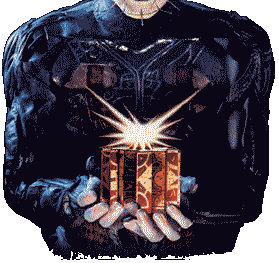 | DVD cover artwork for Hellraiser.
[click photo for larger version] |
Unlike the other films in the series, Barker wisely uses the Cenobites sparingly, which only accentuates their strangeness and our terror. This is one of the few times that Barker could actually be said to have attended the school of less is more.
Julia eventually learns of Frank’s fate and agrees to help free him from his supernatural captors. Her love of Frank knows no bounds. Some of the film’s more suspenseful scenes include her luring men back to the house--ostensibly for sex but actually for their blood because only through the shedding of blood (lots of blood) can Frank's body be replenished, allowing him to re-enter this world. But Julia’s attempt at bringing back her lover is complicated with the involvement of Larry’s daughter Kirsty (Ashley Laurence), who is suspicious of Julia’s behavior.
Hellraiser is filled with macabre imagery: one of the Cenobites pieces together fragments of a human face as if it were a jigsaw puzzle; Kirsty solves the puzzle box herself, conjuring up the Cenobites; the still skinless Frank smokes a cigarette in the attic of the house (juxtaposing the surreal and the mundane). The performances by the film’s leads are excellent, especially Claire Higgins, who brings a fierce convincing cruelty to her role. Christopher Young’s lush, sweeping score helps give the film the illusion of being more expansive than its humble low budget origins (though one can’t help but wonder how the film would have fared with Barker’s original idea of having British experimental group Coil compose the soundtrack).
But the film is not without its faults, most notably the flashback sequences of Julia and Frank, which look like they were borrowed from a Harlequin Romance. And New World Pictures’ absurd attempt at Americanizing the film included dubbing most of the actors’ voices (though Claire Higgins fortunately managed to escape that fate).
Barker would go on to direct other films, such as the ambitious yet troubled (production-wise and narrative-wise) epic monster-fest Nightbreed (1990) and the neo-noir horror film Lord of Illusions(1995), but neither of those films managed to capture the public’s fascination as well as Hellraiser did and still does today.
Anchor Bay’s splendid DVD of Hellraiser includes both the widescreen version (1.85:1) and the full-screen version. An excellent audio commentary featuring Clive Barker and star Ashley Laurence, moderated by novelist and screenwriter Peter Atkins, is also included. A theatrical trailer and still gallery is also included. But the best feature on the disc is a new 20-minute featurette entitled Resurrection, which includes interviews with Barker, Laurence, Doug Bradley (Pinhead) and many others from the production. The featurette is admittedly too short and could have used more behind-the-scenes footage -- which makes it far from definitive -- but this is probably the final word on this modern horror classic.













